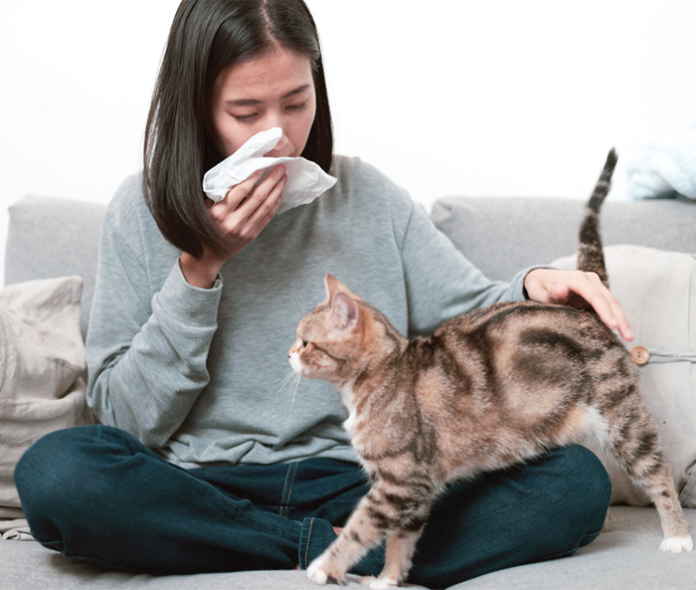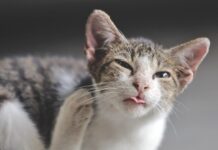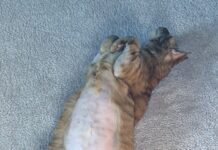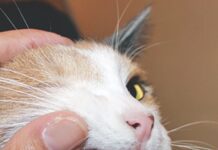If you’re allergic to cats, having a kitty in your life can be a challenge. But there are ways to keep your symptoms under control, and one of them may involve what you feed your cat.
Researchers have looked at the feline allergens that people react to in cat dander. It is not the hair specifically, but rather dried saliva on the coat and the skin. The offending allergen is a glycoprotein called Fel d 1.
What is Fel d1?
The glycoprotein (protein molecule with a carbohydrate attached to it) Fel d 1 is produced by cats in both their salivary glands and in their skin’s sebaceous glands. When cats groom, they add this protein to their hair where it dries as dander. Grooming stimulates release from the sebaceous glands in the skin. All cats produce this protein, although some have lower levels than others. It has been reported that 95% of human allergic reactions to cats are due to this glycoprotein.
Some cat breeds naturally have a lower level of this glycoprotein in their skin and saliva, such as the hairless breeds like Sphynx and Rex. Siberians are long-haired cats, but many of them have lower levels of Fel d 1. Researchers have looked at ways to reduce the amount of Fel d 1 glycoprotein produced by cats, and selective breeding can help, but there is no truly non-allergenic cat breed.
Female cats, especially if spayed, tend to have less of this allergen, followed by neutered males. Intact males produce the highest levels. One study suggested that dark-colored cats tended to have more of the Fel d 1 allergen than light-colored cats, but these results were very preliminary.
Grooming and bathing can keep the amounts of allergen in the environment down. While many cats come to enjoy grooming, bathing is usually not high on the list of fun activities for cats or their owners. Anecdotally, wiping your cat with a non-toxic unscented dryer sheet or other pet-safe wipe may help to pick up some of the dander as well.
A recent study from Switzerland used a vaccine to stimulate an antibody response by cats against their Fel d 1 glycoprotein. There has been no important biological function found for Fel d 1, so this was considered a possible safe approach for cats and their humans.
This study showed that Fel d 1 production was reduced in the 50 cats included in the study. Three boosters were used, with the last one given at 32 weeks. How long the effect lasts is unknown at this time. No toxic effects were noted, but further studies are needed.
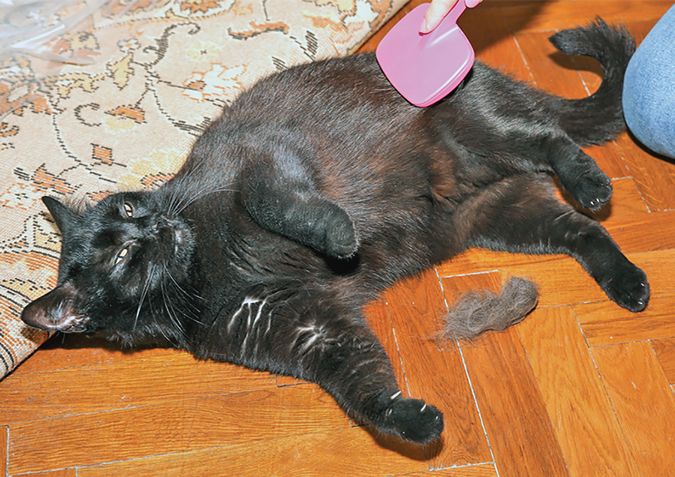
Photography Vadym Plysiuk | iStock Photo
Maybe a Food Solution
Researchers from Purina took a different approach. Their premise was that they could come up with a food that might reduce the Fel d 1 that is produced by cats. The first step was to identify a food additive that binds to the Fel d 1 glycoprotein. They started with IgY, which is an avian immunoglobulin. Chickens produce IgY naturally if exposed to cats, and it is similar to mammalian IgG. In chickens, this immunoglobulin is concentrated in egg yolks—normally it would provide passive immunity for developing chicks.
The researchers’ hypothesis was that Fel d 1- specific IgY could be built up in chicken eggs and the eggs could then be included in the cat’s food. The IgY consumed by cats would then bind to the targeted antigen proteins and decrease their activity.
In this study, 106 cats were fed a control diet for two weeks. They then ate a diet containing anti Fel d 1 IgY for 10 weeks. This diet was a kibble with a coating of the egg protein mentioned above. The egg protein binds to the Fel d 1 in the saliva of the cat eating this diet, reducing the amount of active allergen spread while grooming. Hair was collected twice weekly during the control period and weekly during the 10 test diet weeks. The hair was analyzed for Fel d 1 concentrations.
By the end of the 10 weeks, 97% of the cats in the study had a decrease in amounts of Fel d 1. The average decrease was 47%, and cats with the highest initial levels of this allergen showed the greatest decrease.
Scientists needed to know if this drop in Fel d 1 would help human allergy sufferers. They set up a series of environmental chambers in which people with feline allergies would spend up to three hours with a blanket that had been used by cats without the special diet or one from cats on the special diet. Symptom scores for the volunteers showed a decrease when they were exposed to the special diet cat blankets vs. the control diet and high-level blankets.
The Fel d 1-lowering diet is not currently available to consumers, but Purina hopes to have it out in the near future. Meanwhile, most importantly, research continues to be sure that cats will not have ill effects from a decrease in their normal amounts of Fel d 1.
Immunotherapy
One form of immunotherapy involves being exposed to a small dose of an allergen repeatedly to desensitize your immune system. This might be an injection or an oral dose of the offending allergen. Some people eventually develop a complete resolution of their symptoms, but most people require ongoing immunotherapy.
Continual exposure to cats will usually decrease reactions in many people with feline allergies, although this effect is often “cat specific,” meaning that their reaction to their own cat, but not to others, will decrease.
What You Can Do
- Mop and vacuum frequently, with a HEPA filter on the vacuum. Clean upholstered furniture, floors, curtains, blinds, and drapes.
- Consider leather furniture, which can help keep dander accumulation down.
- Get rid of carpets where you can.
- Wash bedding, pillows, furniture covers, and cat beds at least weekly.
- Change furnace and air conditioner filters regularly; use HEPA filters.
- Regularly brush your cat to remove hair and dander.

